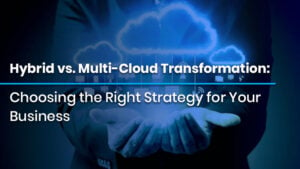
How to Strengthen Security Using CIS Controls and Posture Analysis
How to Strengthen Security Using CIS Controls and Posture Analysis Introduction In the fast-paced and ever-evolving world of cybersecurity, defending digital infrastructure goes far
Enhance your Skills in Cloud Computing , IP Networking , Microsoft , Artificial Intelligence , Cybersecurity and Many More . Come and Join IPSpecialist.

How to Strengthen Security Using CIS Controls and Posture Analysis Introduction In the fast-paced and ever-evolving world of cybersecurity, defending digital infrastructure goes far

How to Prepare for the AWS Data Engineer Exam Introduction With the world becoming increasingly data-driven, organizations are depending on cloud-based systems to store, process,

Hybrid vs. Multi-Cloud Transformation: Choosing the Right Strategy for Your Business Introduction In the digital-first economy of today, cloud transformation is no longer a
Table of Contents
Blockchain is a shared and immutable ledger that allows us to record transactions and track the assets in a business network. In the inherent design of Blockchain, the data cannot be modified, which makes it very secure for cybersecurity, payments, and other similar industries where data security is more important.
Blockchain is a rapidly growing technology, and it helped us build trust, transparency, security, and the trackability of the data shared among a group of individuals or business networks. It reduces security and data breaches by creating blocks and chaining them together.
Dive deeper into the world of cloud technology and IT mastery with IPSpecialist! Get the best course by accessing comprehensive IT certification training and resources. From beginner-level IT courses to mastering Microsoft, Cloud Computing, Cybersecurity, Networking, DevOps, and more, IPSpecialist offers diverse courses, study guides, and practice exams tailored to amplify your skills.
There are three valuable concepts under Blockchain: blocks, nodes, and miners.
Blocks: A Block is like a general block, but multiple blocks are used in the chain. Sometimes, it is referred to as Distributed Ledger Technology (DLT), which makes modifying any data or digital asset unalterable. Take a look at this DTL Properties.
Let’s take a simple example to understand Blockchain easily. Suppose you are using Google Docs, and whenever you create a document, share it with others. The actual document isn’t copied or transferred. Instead, it is distributed among the people you share. It is similar to the decentralized distribution chain where everyone can access the document, and the modifications are recorded in real-time.
Therefore, Blockchain is just like a database where the encrypted data blocks are stored and chained together to create a single reliable source for that data. The digital assets in blockchain technology are distributed instead of copying or transferring the document. The shared digital asset is accessible to everyone in real-time, and transparency is made public. Blockchain technology has become more reliable and promising as it helps reduce the risk of fraud and data alteration.
Blockchain collects the data from a group of individuals known as blocks and stores that information in its databases. The blocks containing the data have a specific capacity to store that information, and when the data is filled in, closed, and linked with other blocks, it creates a chain of data known as a Blockchain.
Let us see how Blockchain works step-by-step below:
Blockchain has three components that contribute to the functioning of this technology, and these three components are Blocks, Hash, and Nodes.
In this step, the data is stored in blocks where each block contains different data types based on the type of Blockchain. Suppose the data is about a cryptocurrency like Ethereum, then the blocks have the information about the transactions, amount, sender, and receiver. This way, the information it stores is about the type of Blockchain.
Hash works very similarly to the methods used for authentication, such as fingerprints. This hash is also included in the block. A hash is continuously computed on the creation of a block. And if anything is changed within the block, the hash will also change. So, it keeps track of all the changes that are made. However, changing any block requires the computation of a complex mathematical problem, which is extremely difficult.
When a block is successfully mined (“Mined” in blockchain refers to validating and adding transactions to the blockchain ledger through solving complex puzzles, securing the network, and often rewarding miners with cryptocurrency coins.), then the change is accepted by the blockchain network. And in return for this, the miner is rewarded financially, just like it works with Bitcoin or other crypto miners.
Decentralization is a fundamental concept when we talk about Blockchain technology. A computer or an organization cannot own any chain. But it is distributed among the computers and organizations. This way, the Blockchain is neither copied nor transferred to the organization or a system. It is distributed via nodes. The network algorithm updates, trusts, and verifies the newly mined block.
Blockchains are of four types that are as follows:
Public: A public blockchain is a decentralized, distributed ledger that allows anyone to view and add records. Because public blockchains are open, transparent, and immutable, they can revolutionize how we interact with the digital world. For example, public blockchains could create a decentralized internet, where users control their data, and Bitcoin and Ethereum are examples of public blockchains.
Private: A private blockchain is a ledger only accessible to specific users. Businesses often use this type of Blockchain to keep track of internal transactions. A private blockchain is where one organization keeps read and write permissions centralized. A private blockchain is permissioned, meaning specific nodes can join the network and validate transactions. For a private blockchain, a centralized authority usually dictates who is allowed to join the network.
Consortium: A consortium blockchain is a public and private blockchain hybrid. It is a decentralized ledger that is accessible to a group of users. Unlike a public blockchain, a consortium blockchain has a restricted group of users who can access the network and participate in the consensus process. Banks and other financial institutions often use this type of Blockchain.
Hybrid: A hybrid blockchain is a type of Blockchain that combines features of both public and private blockchains. A hybrid blockchain is a public blockchain with some features of a private blockchain.
Blockchain technology is used in various industries such as supply chains, retail, financial services, healthcare, etc.
Here are some simple use cases of Blockchain technology:
Various advantages of Blockchain include the following:
There are several potential applications of blockchain technology. Some of the most promising applications include:
Blockchain is a rapidly growing technology, and experts predict a significant rise in its future demand. Market analysts forecast a compound annual growth rate (CAGR) of over 67%, reaching a market value of $137.8 billion by 2030. Several factors are driving this growth, including:
Increased demand for digital identity and security: Blockchain offers a secure and transparent way to store and manage digital identities. This is becoming increasingly important as more and more of our lives move online.
Growing adoption across industries: Blockchain is being explored and implemented in various industries, including supply chain management, healthcare, finance, and voting. As businesses become more familiar with the technology, we can expect even broader adoption in the future.
Development of new applications: New applications for blockchain technology are constantly emerging. For example, blockchain is being used to create new forms of digital assets, such as non-fungible tokens (NFTs).
Blockchain is a rapidly growing technology with enhancements in its development. It enabled new developments such as smart contracts, which are extremely useful for automating some processes.
Companies have also started implementing this technology in various fields such as tax calculation, the healthcare sector to keep medical records, e-notary fields, etc. Blockchain makes it easy for these platforms to make transactions and keep the records of these transactions more secure in the databases. It also reduces the involvement of third parties while doing these transactions.
The main goal of Blockchain is to allow the details of the digital transaction to be recorded and distributed. It also restricts data alteration, creating a foundation for immutable ledgers where digital data cannot be altered or deleted.
Blockchain technology is good for building trust among unknown parties from two locations to make payments. It is also better for providing transparency and traceability of the data shared across the business network.
© 2025 All rights reserved | Privacy Policy | Terms and Conditions | Sitemap | Cookie Policy




